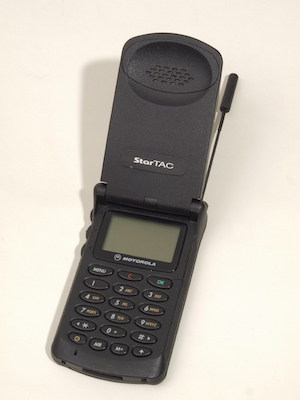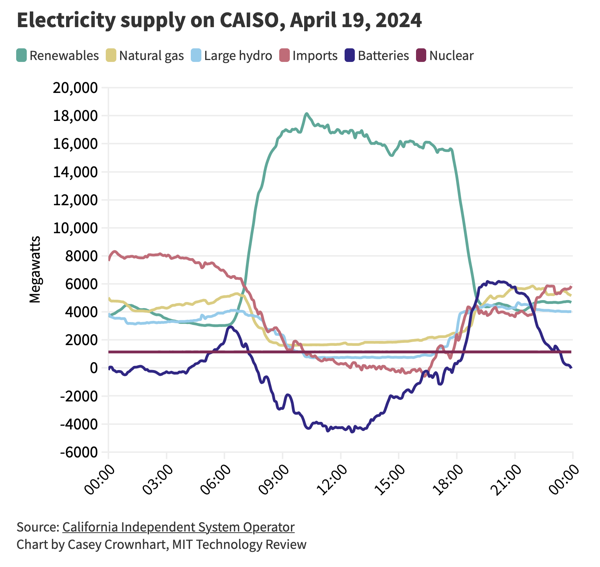Issue 107: A Power Packed Thread of Articles about the Humble Battery
Batteries are among the technologies that have had a silent, dramatic change over my lifetime. Last week, as I was setting up a blood pressure cuff for my mother, I opened the compartment in the back and realized I needed 4 AA-sized batteries. It was once common for devices to ship without batteries, and my inner voice groaned with the thought of having to make a run to the store. So I was pleasantly surprised when two packs of 2 AA batteries fell from the package. I don't know if some regulation has come into effect that requires battery-powered devices to include the batteries, or whether they have simply become cheap enough to toss into every package. But somewhere over the past 20 years, the routineness of batteries has changed.
Today's journey in Thursday Threads takes us down the road of literally electricity storage innovation. As the world continues to lean towards a more renewable future, advances in battery technology is a race we're all invested in, without even realizing it. From manufacturing improvements to cost reductions and a decreased environmental impact, the leaps in battery tech are quite palpable. Plus, one thing I learned this week and a cat picture.
- New battery tech is improving the cost, efficiency, and environmental impact of manufacturing.
- One innovation is "harvesting" nickel metal from plant roots, particularly around spoils from traditional mining operations.
- Battery technology has improved, so you might need to update your knowledge about these battery myths.
- Remember how the EU required devices to use USB-C? It is doing the same thing for user-replaceable batteries by 2027.
- Batteries are starting to have an outsized influence on power generation. How battery technology impacts the electrical grid.
- A fire at a battery facility in California points to the real dangers in relying on batteries for energy storage.
- What about devices without batteries?
- This Week I Learned: It takes nearly 3¢ to make a penny, but almost 14¢ to make a nickel!
- This week's cat
Feel free to send this newsletter to others you think might be interested in the topics. If you are not already subscribed to DLTJ's Thursday Threads, visit the sign-up page. If you would like a more raw and immediate version of these types of stories, follow me on Mastodon where I post the bookmarks I save. Comments and tips, as always, are welcome.
New battery tech
The race is on to generate new technologies to ready the battery industry for the transition toward a future with more renewable energy. In this competitive landscape, it’s hard to say which companies and solutions will come out on top. Corporations and universities are rushing to develop new manufacturing processes to cut the cost and reduce the environmental impact of building batteries worldwide. They are working to develop new approaches to building both cathodes and anodes—the negatively and positively charged components of batteries—and even using different ions to hold charge. While we can't look at every technology that's in development, we can look at a few to give you a sense of the problems people are trying to solve.
Thinking back again on my childhood, I'm old enough to remember jealously guarding the capacity of the 4 D-cell batteries in my portable radio. I wouldn't dare leave it on while not listening to it...the batteries were an expensive luxury! (And I would be very annoyed at my brother or sister if they took them out for their own needs.)
This article from 2024 describes advances in battery chemistry and manufacturing that have lowered costs, improved capacities, and reduced environmental impact.
"Harvesting" nickel metal from plant roots
Gouging a mine into the Earth is so 1924. In 2024, scientists are figuring out how to mine with plants, known as phytomining. Of the 350,000 known plant species, just 750 are “hyperaccumulators” that readily absorb sky-high amounts of metals and incorporate them into their tissues. Grow a bunch of the European plant Alyssum bertolonii or the tropical Phyllanthus rufuschaneyi and burn the biomass, and you end up with ash that’s loaded with nickel. “In soil that contains roughly 5 percent nickel—that is pretty contaminated—you’re going to get an ash that’s about 25 to 50 percent nickel after you burn it down,” says Dave McNear, a rhizosphere biogeochemist at the University of Kentucky. “In comparison, where you mine it from the ground, from rock, that has about .02 percent nickel. So you are several orders of magnitude greater in enrichment, and it has far less impurities.”
The article discusses a federal initiative to use plants to extract metals from the soil through their root systems. They are calling this "phytomining"; interestingly, this application can help remediate land contamination from traditional mining methods. Thank you, plants!
Battery Myths
For an object that barely ever leaves our palms, the smartphone can sometimes feel like an arcane piece of wizardry. And nowhere is this more pronounced than when it comes to the fickle battery, which will drop 20 percent charge quicker than you can toggle Bluetooth off, and give up the ghost entirely after a couple of years of charging. To make up for these inadequacies, we’ve made all kinds of battery myths. Whether it’s avoiding leaving your phone on charge overnight, or powering off to give the battery a little break, we’re forever looking for ways to eke out a little more performance from our overworked batteries, even if the method doesn’t make an awful lot of sense. To help sort the science from the folklore, we asked a battery expert to give their verdict on some of the most pervasive myths, explain the science behind the rumors and, just maybe, offer us some sage advice on extending the life of our smartphones.
As battery technology has changed, so too must our understanding of them. The myths:
- Even when your battery is at 100 percent, there’s still room for some more charge: True
- Charging your phone in airplane mode makes it charge faster: True (kind of)
- Having Wi-Fi and Bluetooth on in the background is a big drain on battery life: True
- Using an unofficial charger damages your phone: True
- Charging your phone through your computer or laptop will damage the battery: False
- Powering off a device occasionally helps preserve battery life: False
- Batteries perform worse when they’re cold: False (mostly)
- Leaving a charger plugged in at the wall and turned on wastes energy: False (well, maybe a tiny bit)
- You should let the battery get all the way down to 0 percent before recharging: False
- Charging past 100 percent will damage your battery: True (but not for the reason you think)
- Replacing your phone battery gives it a new lease of life: True
Read the article for the reasoning behind each. Of these, I would question the one about using unofficial chargers. Much effort has gone into standardizing on the USB-C connector and its associate Power Delivery specifications. I think we are at the point where the standards won't let that happen.
EU requires replaceable batteries by 2027

The new rules stipulate that all electric vehicle, light means of transport (e.g. electric scooters), and rechargeable industrial batteries (above 2kWh) will need to have a compulsory carbon footprint declaration, label, and digital passport. For "portable batteries" used in devices such as smartphones, tablets, and cameras, consumers must be able to "easily remove and replace them." This will require a drastic design rethink by manufacturers, as most phone and tablet makers currently seal the battery away and require specialist tools and knowledge to access and replace them safely.
The big news in mid-2023 was how smartphone manufacturers would need to design products for the European Union market that allowed for batteries to be replaced. The reason was to enhance sustainability by enabling consumers to easily replace batteries instead of relying on manufacturers or needing special tools. This used to be the norm; in fact, I remember buying a beefier/bulkier battery for my Motorola StarTac and keeping the original battery in my pocket as a spare. But the 2023 EU battery regulation goes beyond just personal devices...it impacts all batteries, including automotive and industrial.
The legislation also includes targets for hazardous substances, waste collection, and material recovery from old batteries, aiming for 61% waste collection and 95% material recovery by 2031. Additionally, there will be requirements for minimum levels of recycled content in new batteries. These regulations impact rechargeable batteries only, but the EU is also considering rules for non-rechargeable ones too. And speaking of EU regulations, that is also why USB-C has become the dominant power and data connection for portable devices.
How battery technology impacts the electrical grid
First, there’s a new special report from the International Energy Agency all about how crucial batteries are for our future energy systems. The report calls batteries a “master key,” meaning they can unlock the potential of other technologies that will help cut emissions. Second, we’re seeing early signs in California of how the technology might be earning that “master key” status already by helping renewables play an even bigger role on the grid. So let’s dig into some battery data together.
The article discusses the current state of batteries and their critical role in future energy systems.
- Battery storage has become the fastest-growing commercial energy technology, with deployment doubling worldwide in 2023, particularly driven by China’s policies requiring energy storage for new renewable projects.
- Batteries are now essential for managing the challenges posed by intermittent renewable energy sources. Take California: batteries have begun to smooth out daily energy demand fluctuations, even becoming the top power source at times as solar energy decreases in the evening. This graph blows my mind.
- Despite these promising developments, we have a ways to go if we're going to replace carbon-intensive electricity generation plants. Fortunately, battery costs have plummeted by 90% since 2010, with projections of an additional 40% decrease by the end of this decade, making renewable energy projects more economically viable compared to traditional fossil fuels.

Issue 102 of Thursday Threads from earlier this year pointed to articles about how renewable energy is overtaking coal in power generation in the United States and how Hawaii replaced its last coal-fired power plant with batteries.
Fire at battery facility in California
A fire at the world’s largest battery storage plant in California destroyed 300 megawatts of energy storage, forced 1200 area residents to evacuate and released smoke plumes that could pose a health threat to humans and wildlife. The incident knocked out 2 per cent of California’s energy storage capacity, which the state relies on as part of its transition to use more renewable power and less fossil fuels.
Of course, as we become more reliant on batteries for storage, there is an increased danger from disasters. A fire at Vistra Energy's Moss Landing battery storage facility in California has caused significant damage, destroying thousands of lithium batteries and 300 megawatts of energy storage capacity. That is quite a bit bigger than a Tesla car fire.
This is not new, of course; the problem was described in a 2023 article in Wired. Despite a 97% reduction in battery-related failures globally since 2018, the loss of such a significant storage capacity is concerning for California's renewable energy goals. The reconstruction of the facility could take years, complicating the state's efforts to reduce fossil fuel dependence. So take a chunk out of that "renewables" line in the graph from the last article.
What about devices without batteries?
Imagine using a health bracelet that tracks your blood pressure and glucose level that you do not have to charge for the next 20 years. Imagine sensors attached to honeybees helping us understand how they interact with their environment or bio-absorbable pacemakers controlling heart rate for 6–8 months after surgery. Whether submillimeter-scale “smart dust,” forgettable wearables, or tiny chip-scale satellites, the devices at the heart of the future of the Internet of Things (IoT) will be invisible, intelligent, long-lived, and maintenance-free. Despite significant progress over the last two decades, one obstacle stands in the way of realizing next-generation IoT devices: the battery.
I'm pretty sure I'm not ready for "smart dust", but this article got me thinking about the potential of batteryless, energy-harvesting systems that could someday surround us. As described in earlier articles in this Thursday Threads, there are environmental challenges posed by traditional batteries, including their limited lifespan and harmful manufacturing and disposal processes. "Batteryless" is as much about how these IoT devices will get power as it is about how programming them will require a different mindset.
This Week I Learned: It takes nearly 3¢ to make a penny, but almost 14¢ to make a nickel
FY 2024 unit costs increased for all circulating denominations compared to last year. The penny’s unit cost increased 20.2 percent, the nickel’s unit cost increased by 19.4 percent, the dime’s unit cost increased by 8.7 percent, and the quarter-dollar’s unit cost increased by 26.2 percent. The unit cost for pennies (3.69 cents) and nickels (13.78 cents) remained above face value for the 19th consecutive fiscal year
I knew pennies cost the U.S. mint more than one cent to make, but I didn't realize that the cost of nickels is so much more out of whack. I also learned a new word: seigniorage — the difference between the face value of money and the cost to produce it.
What did you learn this week? Let me know on Mastodon or Bluesky.
Mittens and Pickle want to go on a trip

My wife came back from a trip last week. Do you see the back tuxedo cat among the clothes in the luggage? Pickle sure wants to go along on the next trip. It looks like Mittens would be happy to close the suitcase and send Pickle on her way.